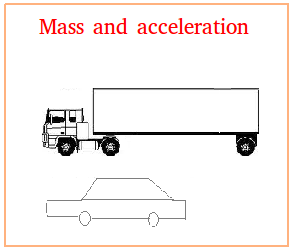Newton's Second Law
Newton's second law of motion is an equation that shows how force and mass work together to produce acceleration. It states the following:
The unit of a is m / s2
The unit of F is Newtons
The unit of m is kg
Before you do the math, you have to make sure that a, F, and m are already in the units mentioned above.
How did Newton come up with such a formula? Newton's second law is the result of some keen observations by Newton.
How can you get an object to move or to accelerate? You must apply some force to this object. To be more precise, you must apply some net force that is not equal to zero.
- What makes an airplane move and fly away?
- What makes your car move?
- What makes a soccer ball fly in the air until it reaches the goal keeper?
- What make a book fly in the air?
I think you got the point! Some force was applied to the object. The force in an engine, a kick, and the force in your hand are all good examples of force that can make things move.
Acceleration is the result of force. This simple sentence becomes as an equation
a = F
However, whenever, there is a mass, you know it can slow down acceleration or movement.
More importantly, the bigger the mass of the object, the more the object will resist motion and the less the object will accelerate.
How do we incorporate the mass? Division usually makes quantity smaller. Therefore, dividing F by the mass makes sense since mass can slow down acceleration.
This is the great idea behind the formula above
a = F/m
Some Important Observations with Newton's Second Law
The acceleration depends on the force and the mass.
In the formula, the force is on top and the mass is at the bottom.
Mathematically, it makes sense as we are about to show.
Let's talk about mass first. Suppose you put the mass on top, what will happen as we increase the mass and apply the same force?
Let us pretend that a = m × Fm = 2 kg and F = 4 N
a = 8 m / s 2
m = 8 kg and F = 4 N
a = 32 m / s 2
The acceleration is getting bigger yet this does not make sense. Since the mass is getting bigger, it is suppose to resist acceleration, not increasing it.
Let's us put the mass at the bottom instead.
a = 2 m / s 2
a = 0.5 m / s 2
The acceleration got smaller as we increased the mass. The formula makes sense now.
As the mass is getting bigger and bigger, it will make the acceleration get smaller and smaller. As the mass is getting smaller and smaller, the acceleration will get bigger and bigger.
This makes perfect sense since it is easier to accelerate a small mass.
Look at the two vehicles below. If they both vehicles ran out of gas. Which one will be easier to push or accelerate?

Now what about the force? Is it fair to say that the bigger the force, the bigger the acceleration?
Most definitely! For example, if you double the force, you also double the acceleration. If you triple the force, you triple the acceleration.
The force has to be on top then. Putting it at the bottom will defy this logic.
Remember what happened when the mass was at the bottom?
The bigger the mass, the smaller the acceleration. Putting the force at the bottom will have the exact same effect.
In its simplest form, Newton's second law can be written as
This end our lesson about Newton's second law of motion.